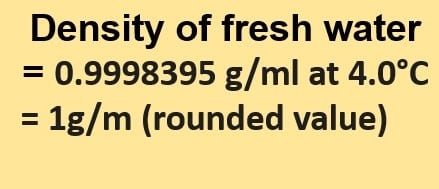Density and specific gravity are two different quantities.
The term “density” refers to an object’s mass per unit volume. It is an absolute quantity with SI units of kg/m3. The specific gravity of a material is simply the ratio of its density to that of water at 4 degrees Celsius. Specific gravity is a relative quantity with no units. Another name for specific gravity is relative density.
For instance, the density of water is 997 kg/m3, whereas the specific gravity of water is one.
This post explains the difference between density and specific gravity.
Table of Contents
What is Density?
Density refers to the amount of substance per unit volume. It is the mass-to-volume ratio of a substance. If we use the same amount of wood and iron, we will find that iron is significantly heavier than wood. This is owing to the fact that iron contains a lot more matter than wood.
Density Formula and Daily Life Examples
Density formula = mass (m) of substance ÷ volume (v) of substance
The density of a substance is usually measured in grams per cubic centimeter. For example, the density of water is 1 gram per cubic centimeter.
Some simple examples of density are given below
- A less dense styrofoam cup floats on water rather than sinking.
- Oil has a lower density than water that’s why it floats on the surface of the water.
Please refer to the full article, “Why does oil float on the surface of the water?”. - Less dense wood floats on the surface of the water.
- Heavy rocks sink in water as they are denser than water.
What is Specific Gravity?
A material’s specific gravity is defined as the ratio of its density to that of water at 4 °C (where it is most dense and is taken to have the value 999.974 kg/m3). It is a relative number that does not have units.
Water has a specific gravity of one at 4 degrees Celsius. This is the value that scientists use to calculate the specific gravity of other substances.
Difference Between Density and Specific Gravity
| Density | Specific gravity | |
| Formula | mass/volume | the density of a substance/density of water at 4 °C |
| Units | kg/m3 | no units |
| Symbol | ρ | SG, or sometimes just G |
| Other names | Mass density | Relative density |
| Applications | Density is an important concept as it tells us which substances will float and which will sink when placed in a liquid. | The specific gravity of a floating object tells what fraction of that object will be below the water when floating. Consider a cube of wood floating on water with a specific gravity value of 0.2. This indicates that 20% of the hardwood cube will be submerged in water. |
The density of Water in g/ml
The density of water is about 1g/ml, but this value changes with the presence of impurities or changes in temperature. Commonly used units of ρwater are gram per milliliter (1 g/ml), gram per cubic centimeter ( g/cm3), and pounds per cubic foot (lb/ft3). The density of fresh water at 4°C is usually taken as 1000 kg/m3.
The Specific Gravity of Water
Specific gravity (G) of a substance is its density divided by the density of water.
The specific gravity of water is one. It is the ratio of a material’s density with that of water at 4 °C. We take the density of water at 4 °C as the water is most dense at this temperature. The density of water is 999.974 kg m-3.
Specific gravity is a ratio so it has no unit.
Summary
- Specific gravity and density are two terms that are used to describe mass and can be used to compare different substances. However, there is a difference between density and specific gravity.
- Density is mass per unit volume of a substance.
- Specific gravity is the ratio of a material’s density with that of water at 4 °C.
More Links
Unit Weight of Water| Specific Weight
How Many Cups in a Gallon? Cups to Pints, Quarts, and More
Gravitational Potential Energy (w=mgh)
Conduction in Physics| Easy Examples
The Density of Oxygen| Commonly Used Units
How Much is a Liter of Water?| Glasses, Bottles, Cups
- BCl3 Lewis Structure in four simple steps - November 1, 2023
- PH3 Lewis Structure in four simple steps - October 8, 2023
- PF3 Lewis structure in four simple steps - September 24, 2023



